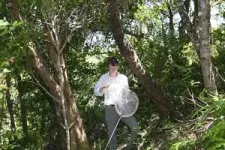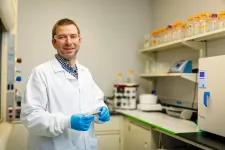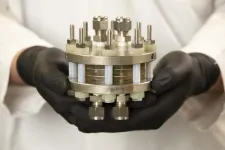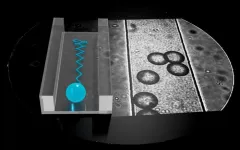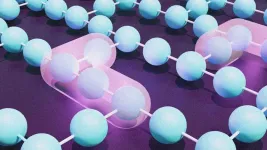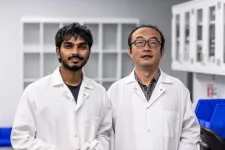(Press-News.org) Ultrasound, once used almost exclusively to take images of the body, is quickly developing into a targeted therapy that can have a potentially life-changing impact on our brains, according to the authors of a new article.
For decades, health professionals across the world have used ultrasound as a means of monitoring the development of unborn babies and assessing the health of patients’ internal organs.
But writing in the journal PLOS Biology, researchers from Stanford University, the University of Plymouth, and Attune Neurosciences say it has now been demonstrated to offer a non-invasive and precise way of targeting specific areas of the human brain.
This is enabling them to investigate how a technique known as transcranial ultrasound stimulation (TUS) can help people with conditions ranging from pain, alcoholism, obsessive-compulsive disorder (OCD), and Parkinson’s disease, all without the use of drugs or surgery.
Beyond the treatment, the researchers discuss in the new article how the technology can also be used to temporarily test areas before treating them, serving as a sort of “search and rescue tool for the brain”.
This enables them to find the sources of brain-related issues and disorders prior to treating them, which may be on the critical path towards personalized treatments.
However, they acknowledge there are still a number of complex challenges that need to be addressed before TUS can be rolled out in healthcare settings – and maybe even homes – on a global scale.
These include the fact that each of the 8.2 billion brains and skulls on the planet is different, and work is still required to tailor the technique so that it can be delivered in such a way as to enable as many people as possible to benefit from it.
And while significant advances have been made to the technology, reaching a point where it can still be effective – but also sustainable from a cost perspective – is still some years away.
But at present the researchers have developed and are testing a TUS device small and simple enough for people to use them at home following a series of clinical assessments, rather than having to continually go into hospitals or other healthcare settings.
The article was written by Dr Keith Murphy, co-founder of Attune Neurosciences and researcher at Stanford University School of Medicine, and Professor Elsa Fouragnan, who leads the Brain Stimulation Lab in the University of Plymouth’s Brain Research and Imaging Centre.
Dr Murphy said: “There are countless reasons people can’t get to a clinic, whether it’s financial strain or simply not having the time. In the past few years, we’ve made substantial progress towards a device that leverages MRI precision guidance but may still be used safely at home. We’ve always believed that portability was a critical step towards making advanced brain therapies accessible to everyone and we’ve made great strides in demonstrating that it works.”
The researchers further discuss how focused ultrasound can also be integrated with other emerging technologies, for example improving the accuracy and effectiveness of interfaces that enable direct communication between the brain and external devices.
Professor Fouragnan added: “Over many years, we have improved our understanding of how the brain works and the failings within it that lead to neurological and mental health conditions. However, while advances have been made in treatments, they have not happened at a similar pace. We believe TUS can fill that gap and through our research to this point, we have discovered how it can be a genuine search and rescue tool for the brain. Clinicians and patients are excited about its potential, and if the current pace of development continues, we could have a risk-free technology that can positively impact millions, if not billions, of people.”
What is transcranial ultrasound stimulation? Watch a video explaining the technique on the University of Plymouth’s YouTube channel. END
Ultrasound can be used as search and rescue tool for the brain
2024-10-29
ELSE PRESS RELEASES FROM THIS DATE:
Department of Defense funds study of gene therapy for muscular degeneration
2024-10-29
The U.S. Department of Defense awarded just under $514,000 to an interdisciplinary team of researchers at the U of A to study the efficacy of “self-delivering” gene editors in the treatment of Duchenne Muscular Dystrophy, or DMD.
DMD results from a mutation in the dystrophin gene and is one of the most severe inherited muscular dystrophies, leading to deterioration of the muscle fibers. Presently, there is no cure, but advances in treatment have helped patients live longer, better lives.
Gene therapy designed to ...
People’s exposure to toxic chemicals declined in the U.S. following listing under California law
2024-10-29
With growing concern about the ubiquity of toxic chemicals in consumer products, many states have passed laws aimed at protecting people from harmful substances in everyday items like cosmetics, cleaning supplies, plastics, and food packaging. California’s Proposition 65, for instance, is considered one of the most extensive toxics laws in the country.
But does the law work? According to a new study published in the journal Environmental Health Perspectives, it does.
“Not only have people’s exposures to specific toxic chemicals gone down in California, ...
Trauma, homelessness afflict gender affirming care patients at higher rates
2024-10-29
A survey of patients receiving gender affirming care shows that commercial insurance pays for most of their treatments, they receive less care in the South than other parts of the U.S. and they deal with disproportionate levels of housing insecurity and trauma compared to others, according to a new study by researchers at the Colorado School of Public Health and the University of Colorado Anschutz Medical Campus.
The study, using data provided by Kythera Labs, a healthcare clearinghouse, examined millions of insurance claims by patients undergoing gender affirming care (GA) and those not. It also looked at social determinants of healthcare (SDOH), non-medical factors ...
New $5 million DoE award supports KU startup’s green hydrogen energy research
2024-10-29
LAWRENCE — With $5 million in support from the U.S. Department of Energy, the University of Kansas and Avium — a startup firm founded by researchers from KU’s School of Engineering — aim to make clean hydrogen more affordable.
According to the DoE, the work at KU is part of $750 million in funding for 52 projects across 24 states “to dramatically reduce the cost of clean hydrogen and reinforce American leadership in the growing hydrogen industry.”
Green hydrogen is a key tool in the worldwide ...
A navigation system for microswimmers
2024-10-29
Microswimmers often need to independently navigate narrow environments like microchannels through porous media or blood vessels. The swimmers can be of biological origin, like algae or bacteria, but also constitute custom designed structures used for the transport of chemicals and drugs. In these cases, it is important to control how they swim in relation to walls and boundaries - as one might want them to exchange fuel or information, but also avoid them to stick where they are not supposed to.
Many swimmers are electrically ...
Study finds early TAVR can be beneficial for patients with asymptomatic severe aortic stenosis
2024-10-29
WASHINGTON, DC – OCTOBER 28, 2024 – The first powered randomized trial examining early intervention with transcatheter aortic valve replacement (TAVR) in patients with asymptomatic, severe aortic stenosis (AS) found this strategy to be both a safe and effective alternative to clinical surveillance (CS).
Findings were reported today at TCT 2024, the annual scientific symposium of the Cardiovascular Research Foundation (CRF). TCT is the world’s premier educational meeting specializing in interventional ...
Implantable microparticles can deliver two cancer therapies at once
2024-10-29
Patients with late-stage cancer often have to endure multiple rounds of different types of treatment, which can cause unwanted side effects and may not always help.
In hopes of expanding the treatment options for those patients, MIT researchers have designed tiny particles that can be implanted at a tumor site, where they deliver two types of therapy: heat and chemotherapy.
This approach could avoid the side effects that often occur when chemotherapy is given intravenously, and the synergistic effect of the two therapies ...
Early intervention in patients with asymptomatic severe aortic stenosis and myocardial fibrosis falls short of expected benefits
2024-10-29
WASHINGTON, DC – OCTOBER 28, 2024 – The EVOLVED trial found that early aortic valve intervention in patients with asymptomatic severe aortic stenosis (AS) and mid-wall myocardial fibrosis on magnetic resonance imaging did not reduce the incidence of the composite primary endpoint of all-cause death or unplanned aortic stenosis hospitalization compared with guideline-directed conservative management.
Findings were reported today at TCT 2024, the annual scientific symposium of the Cardiovascular Research Foundation (CRF). TCT is the world’s premier educational meeting specializing in interventional cardiovascular ...
The surprising reason a classical computer beat a quantum computer at its own game
2024-10-29
Earlier this year, researchers at the Flatiron Institute’s Center for Computational Quantum Physics (CCQ) announced that they had successfully used a classical computer and sophisticated mathematical models to thoroughly outperform a quantum computer at a task that some thought only quantum computers could solve.
Now, those researchers have determined why they were able to trounce the quantum computer at its own game. Their answer, presented on October 29 in Physical Review Letters, reveals that the quantum problem they tackled — involving ...
Researchers Aim To Get Leg Up on Bone Repair with 3D-Printed Femur
2024-10-29
University of Texas at Dallas mechanical engineers have designed a 3D-printed femur that could help doctors prepare for surgeries to repair bones and develop treatments for bone tumors.
The engineers, who worked in collaboration with UT Southwestern Medical Center orthopedic surgeons, published their first study on the 3D-printed thigh bone online Aug. 5 in the Journal of Orthopaedic Research.
The study, which focused on the middle section of the bone, establishes 3D-printing parameters for a femur for use in biomechanical testing. Researchers said more studies will be needed before the technology could be available for widespread use.
To study and validate innovative surgical implants ...


